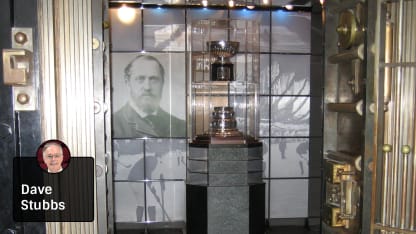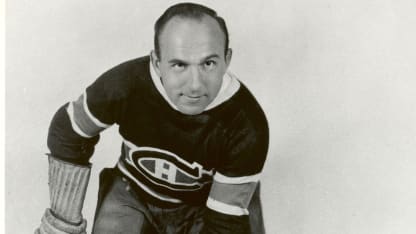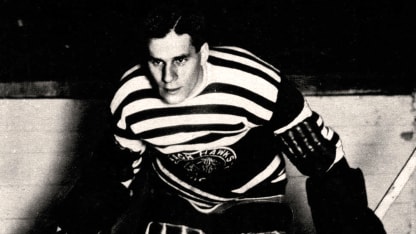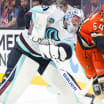MONTREAL -- Members of the
Hockey Hall of Fame Class of 2016
, announced Monday, might be hard pressed to tell you much about Captain James Thomas Sutherland. But the latest honorees might soon wish to leaf through the pages of history to the roots of the storied club to which they now belong.
The Hall of Fame now includes 271 players, 105 builders and 16 referees and linesmen. The doors to the Class of 2016 didn't open Monday, but rather in 1945, when Sutherland's dream of a hockey shrine became reality about 160 miles east of its current downtown Toronto location.
How 'Father of Hockey' founded original Hall of Fame
Sutherland, inaugural HOF class from 1945 remembered as 2016 inductees announced Monday

Sutherland was known in the 20th century as the "Father of Hockey" for his tireless work administering and promoting the game.
The native of Kingston, Ontario, was born in 1870, three years after the birth of Canada as a nation. Sutherland played hockey until his late teens for, among others, the Athletic Club of Kingston, Canada's first official league.
After his playing days, he would turn his attention to officiating, coaching and researching the history of hockey, increasing its profile as he did. Sutherland boldly declared his hometown as the birthplace of the sport, a claim that has been disputed by many, including Montreal, at least two cities in Nova Scotia, Canada's Northwest Territories, and a group of historians in Great Britain.
First involved as a player, then as a referee and a coach, Sutherland would serve as president of the Ontario Hockey Association from 1915-17 and the Canadian Amateur Hockey Association from 1919-21, selling shoes to make ends meet.
A veteran of World War I, he resolutely set off to establish a place to celebrate hockey and its early stars and pioneers. In 1938, Cooperstown, N.Y., was selected as the home of the National Baseball Hall of Fame, an appropriate choice given that the town was recognized as the cradle of the sport. Sutherland saw no reason why a shrine to hockey couldn't similarly be established in Kingston.
In the 2003 Hockey Hall of Fame book "Honoured Members," author Andrew Podnieks chronicles Sutherland's substantial efforts during World War II to build a shrine to hockey in his hometown, his plan agreed upon on Sept. 10, 1943 by the Canadian Amateur Hockey Association and the NHL.
It was Sutherland's stated desire "to perpetuate the memories of the men who have done so much to develop nationally and internationally Canada's great winter sport."
A huge collector of hockey memorabilia, Sutherland put up $1,000 of his own money and had more raised with the help of Kingston Mayor Stuart Crawford to create the International Hockey Hall of Fame.
But construction delays and soaring costs brought the Kingston shrine to physical life only in 1965, a decade after Sutherland's death and four years after the NHL's Hockey Hall of Fame opened in Toronto.
Even without a roof over its head, Sutherland's Hall began honoring hockey's legends in 1945. The class included Hobey Baker, Howie Morenz, Georges Vézina and Lord Frederick Arthur Stanley.

Sutherland, the pioneer whose dream was to honor hockey's greatest names, was inducted by the shrine in 1947, among its second class that numbered 14.
The "Original Hockey Hall of Fame," as the Kingston shrine calls itself, still flourishes, in 2013 having celebrated its 70th anniversary.
The more famous Hockey Hall of Fame moved in 1993 from the grounds of Toronto's Canadian National Exhibition to BCE (now Brookfield) Place, a magnificent former bank building in which many of the game's priceless artifacts are displayed alongside its most important people.
Monday's additions add yet more luster to hockey's most special showcase, one that celebrates a rich history written over more than seven decades by the greatest of the greats.
Here is a complete list of the inaugural class in Sutherland's Hall of Fame:
-- American collegiate legend Hobey Baker, whose name is attached to the award that annually recognizes the best college player in the U.S.

-- Chuck Gardiner, a Scot who twice won the Vézina Trophy as the NHL's best goaltender.
-- Eddie Girard, an Ottawa Senators star who won two Stanley Cups with that team and another with the Toronto St. Pats when loaned to the short-staffed team because of injury.
-- Frank McGee, one of hockey's greatest early-era snipers, shined with the Ottawa Silver Seven despite having no vision in one eye after being struck by an errant puck.
-- Howie Morenz, the Montreal Canadiens forward and the NHL's first true superstar, was voted as the best hockey player in the first half of the 20th century.
--Tommy Phillips, whose 1905-07 stint with the National Hockey Association's Kenora Thistles defined his hockey life, coming up short against Ottawa in the 1905 Stanley Cup. He played a key role in the Thistles' championship win against the Montreal Wanderers two years later.
--Harvey Pulford, a superior all-round athlete who for a decade and a half from the late 1800s sparkled in Ottawa, regarded as the first puck-rushing defenseman in hockey.
-- Hod Stuart, a top-flight amateur in Ottawa and Quebec City before heading to Pittsburgh in 1902 to turn pro, was tragically lost that year when he dove from a deck into shallow waters and broke his neck while on summer vacation.
-- Georges Vézina, the magnificent goaltender for the Montreal Canadiens who was so unflappable under fire that he was nicknamed the "Chicoutimi Cucumber," a nod to his hometown. In 1927, upon his death, the Canadiens donated a trophy to the NHL bearing his name, awarded to the League's best goalie.
The two builders:
-- Sir Montagu Allan, a sportsman and wealthy financier who in 1909 donated the Allan Cup to reward Canada's best amateur team. It filled a void in the amateur ranks, with the Stanley Cup having become the top prize of the professionals.
-- Frederick Arthur Stanley, Lord Stanley of Preston, Earl of Derby, Canada's Governor-General in the late 1800s and a loyal fan of hockey whose donation to the country in 1893 forever changed the game. The Stanley Cup, a silver bowl seven inches high and 11 inches wide, commissioned in London by Lord Stanley for the sum of 10 guineas (approximately $50 Canadian at the time), has grown in physical size and mythical stature through the generations.

















